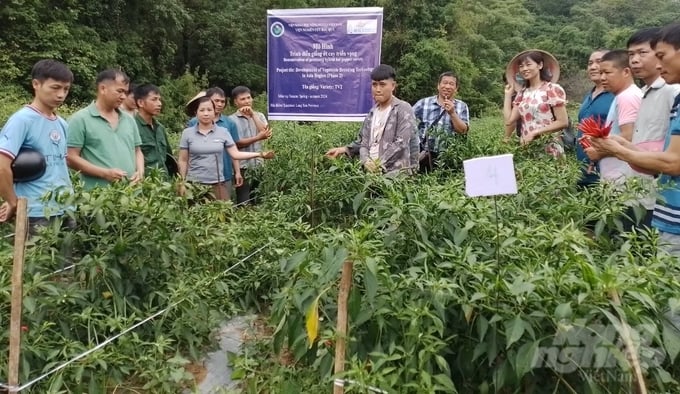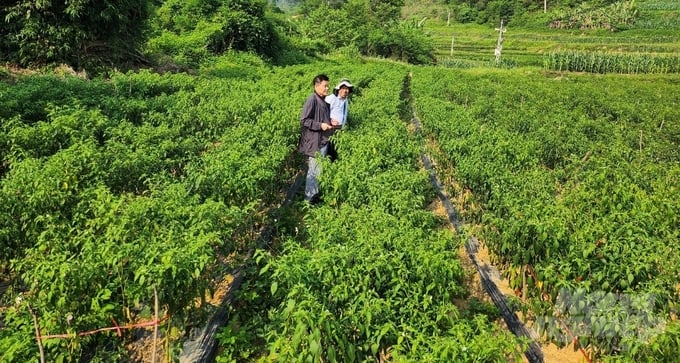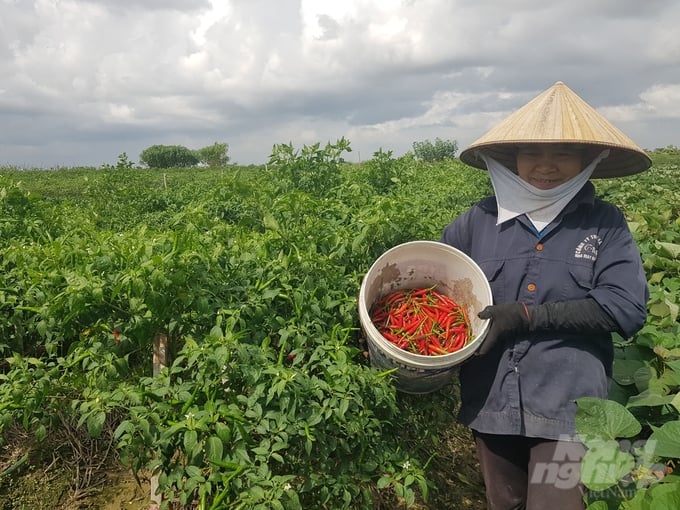November 25, 2025 | 11:51 GMT +7
November 25, 2025 | 11:51 GMT +7
Hotline: 0913.378.918
November 25, 2025 | 11:51 GMT +7
Hotline: 0913.378.918
The Fruit and Vegetable Research Institute (Vietnam Academy of Agricultural Sciences) has recently collaborated with the Farmers' Association of Van Thuy Commune (Chi Lang, Lang Son) to evaluate the demonstration production model of the hybrid chilli variety F1 Hafam 6. In addition to local farmers, several enterprises from South Korea also participated in the model evaluation.

Farmers in Van Thuy Commune visited and evaluated the Hafam 6 chilli planting model. Photo: Hai Tien.
The Hafam 6 hot chilli planting model covers nearly 2 ha in Ban Du Village (Van Thuy Commune) during the spring-summer 2024 season. The chilli plants are currently in full harvest, with an average yield of 22.5 tons/ha (8.3 quintals/360 m2). Households with good intensive farming practices achieve yields of over 10 quintals/Sao.
Mr Vi Van Phuong, who planted 5 Saos of Hafam 6 chilli within the model, expects to harvest 4.5 tons of chilli by the end of the season, corresponding to an average yield of 900 kg/Sao (24.3 tons/ha). Mr Phuong noted that the Hafam 6 chilli variety has a similar yield to the control variety (VA.99999) but boasts advantages such as larger fruits, more concentrated ripening, and a shorter growth period of about 15 days. This shorter growth period allows for an additional winter crop after the spring-summer chilli harvest (such as potatoes, sticky corn, or other short-day vegetables). Additionally, the Hafam 6 hot chilli variety shows good resistance to pests and diseases, particularly anthracnose.

Korean enterprises visited the model in Van Thuy Commune and expressed interest in regularly purchasing Hafam 6 hot chilli. Photo: Hai Tien.
Mr Kim Dong Won, Chairman of Five Agency Co. Ltd, and Mr Lee, Chairman of KoFarm (Korea), highly praised the Hafam 6 chilli variety after visiting the model. They both expressed readiness to consistently buy chilli fruits to use as a spice for kimchi production. However, the current production scale is quite small (nearly 2 ha), so it needs to be expanded to meet the regular purchase volume of one 20-foot container (20 tons) of fresh chilli per week (every 7 days). Additionally, there is a significant need for cold storage facilities to preserve the fruits.
Ms Nguyen Thi Thoan, Chairwoman of the Van Thuy Commune Farmers' Association, stated that chilli is one of the main agricultural crops in Chi Lang District, with an annual planting area ranging from 300 to 700 ha. The produce is primarily exported through border trade to China, causing the planting area and chilli prices to fluctuate frequently. Now, with scientists introducing new varieties, intensive farming techniques, and connecting with purchasing enterprises, farmers are very excited.
Currently, in Chi Lang, chillies are rotated with wet-season rice, which significantly reduces various pests and diseases. Thanks to growing chillies in the off-season during the spring-summer crop compared to other chilli-growing regions in Vietnam and China, there is a great potential for chilli cultivation development in Lang Son if organised effectively.
In addition to the demonstration of the F1 hybrid Hafam 6 hot chilli in Van Thuy Commune, the Vegetable Research Institute is also trialling other hot chilli varieties such as TV1, TV3, and TV4, which local farmers have initially evaluated as highly promising.

The demonstration model of Hafam 6 hot chili cultivation in Quynh Hoi Commune (Quynh Phu District, Thai Binh). Photo: Hai Tien.
The Hafam 6 hot chilli variety is an F1 hybrid bred by MSc. Dang Hiep Hoa and colleagues from the Department of Vegetables and Spices (Vegetable Research Institute). It was introduced in 2023 and has shown good production results in various ecological regions across the country, such as Phu Tho, Thai Binh, and others.
The variety is characterized by strong growth and development, good resistance to pests and diseases, early and concentrated fruit harvest, and high yield (22.5 - 27.4 tons/ha). The fruits are upright, of good quality, turning bright red when ripe, which is suitable for domestic consumer preferences and meets export requirements.
"As an exposed (upright) fruit variety, Hafam 6 chilli should be sown early in the spring-summer crop to avoid sunburn damage to the fruit skin. Farmers should utilise pest-damaged and stunted chillies to soak with garlic to make a biological preparation for pest control spraying on various crops, including chillies," informed Dr Ngo Thi Hanh, Head of the Department of Vegetables and Spices (The Fruit and Vegetable Research Institute).
Translated by Hoang Duy

(VAN) The information was shared at the seminar 'Urban Agriculture - Solutions for Developing Green Spaces,' organized by the Kinh te & Do thi Newspaper and the Biotechnology Center of Ho Chi Minh City.
/2025/11/19/4141-2-132831_216.jpg)
(VAN) One of Japfa's outstanding solutions is implementing digital transformation and artificial intelligence (AI) to optimize operations, enhance productivity, and advance sustainable development.
/2025/11/19/4847-1-093540_448.jpg)
(VAN) The Gia Lai Provincial People’s Committee had a working session with the delegation of the U.S. Department of Agriculture, the State of Idaho, and representatives of the State's leading enterprises.

(VAN) Ca Mau has a sufficient foundation to become a strong regional aquaculture center, where production integrates the economy, the environment, and the lives of the people.

(VAN) SEIKI Group envisions itself as a pioneer in the ‘dual transformation’ of digital technology and green industry, standing alongside the Government and Vietnamese businesses in their pursuit of sustainable development.

(VAN) The VNGEONET network affirms Viet Nam's progress in mastering digital space, providing a precise positioning data platform to serve socioeconomic development.
/2025/11/14/3247-1-184556_35.jpg)
(VAN) Thai Nguyen is methodically implementing digital transformation in the livestock sector, laying the foundation for a modern, transparent, and sustainable agriculture.